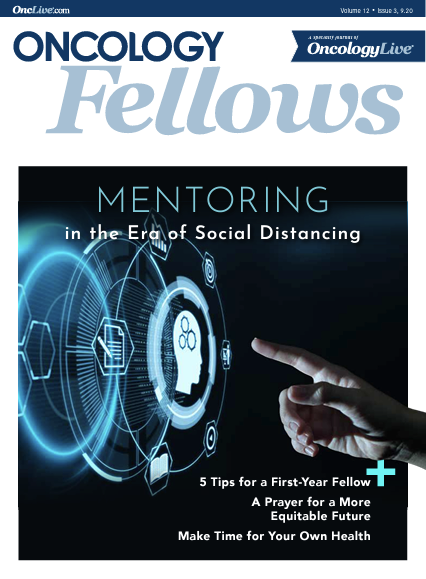Publication
Article
Oncology Fellows
Mentoring Oncologists in the Era of Social Distancing
Author(s):
Mentoring is critically important to the development of young academic hematology/oncology trainees.
Richard Martin, MD, MPH

Mentoring is critically important to the development of young academic hematology/oncology trainees. Key elements of an optimal mentor-protégé relationship include regular meetings, setting expectations, making time to listen, assessing progress, and promoting protégés.1
Chief among those elements is effective 2-way communication, which, when working well, is a major facilitator of mentor and protégé success. When working poorly, such communication is a major barrier to a successful relationship.2
The novel coronavirus disease 2019 (COVID-19) pandemic affected several aspects of medical practice, including continuing medical education and trainee mentoring. In-person mentoring was possible but infeasible because of social distancing and could not address the challenges of a rapidly evolving educational and practice climate. Consequently, many mentorprotégé relationships were no longer operating under their optimal context, especially with respect to regular meetings and effective communication.
To address these challenges, a group of trainees and fellows created the Hematology Oncology COllaborative VIDeoconferencing (COVID) Learning Initiative. The project is a trainee driver, multi-institutional online learning platform designed to bring together junior physicians and expert faculty from around the country to collaborate on weekly COVID-19 teaching and to facilitate ongoing remote mentorprotégé relationships centered around program leadership and/or educational presentations.
In just 6 weeks, the initiative brought together a leadership team of 17 protégés and 11 educational mentors from 13 institutions, as well as 11 presenting protégés and 26 topic advisory mentors from 17 institutions. Together, they produced 5 multidisciplinary, online COVID-19 conferences that attracted an average of 100 providers.
Beyond learning about treating patients with cancer during the COVID-19 pandemic, participating in this multi-institutional, remote learning network has been an opportunity for us to learn about the challenges, and benefits, of virtual mentoring. In our experience, we found that the following 3 components are necessary to make virtual mentoring and collaboration a success: "We believe that the model developed and used by the COVID Learning Initiative can be expanded to provide other learning, research, and clinical opportunities for fellows in training.”
Set Specific Expectations
As is true in any mentoring relationship, setting expectations is essential to keep remote mentoring on track. It is important to develop a project timeline with specified deadlines to clearly define roles and responsibilities for both mentors and protégés. Because our project included multiple participants at all levels collaborating on content, as well as multiple groups creating content at varying points in time, we opted to create a document of expectations to share with all participants. This provided an outline to ensure consistency in the content created and also developed a baseline mutual understanding of individual roles and collective group objectives.
There Is No Such Thing as Overcommunication
When members of a multi-institutional group like ours are unable to meet face-to-face, creating clear pathways for rapid and regular communication is essential. Nothing stalls a project’s momentum like an unanswered email, so develop the habit of staying on top of your inbox and replying immediately, even if it is just to confirm email receipt and let the sender know when he or she can expect a detailed reply.
Keep in mind which of the many media available is appropriate for each type of communication. Web conferencing platforms such as Zoom are great for facilitating group discussions, but they should be used sparingly since they take up significant time and can be difficult to schedule. Furthermore, the best meetings on these platforms require a leader to guide the conversation, as the lack of in-person social cues can lead to long silences or strings of interruption that stall idea sharing.
Use email for answers to specific questions from specific individuals. Keep in mind that emails with larger questions for larger groups can lead to multiple responses, crowded inboxes, and a lack of clear consensus. When creating online documents or presentations, consider incorporating shared-document editing platforms such as Google Drive rather than sending drafts back and forth.
Create A Level Playing Field to Share Perspectives
For true collaboration to occur, all contributors need to feel that their perspective is essential, valued, and heard. Because all providers were effectively novices in treating COVID-19, there was an inherent appreciation within our group for each individual’s experience and ideas, regardless of training level. That served to improve collaboration and led to the creation of educational content to meet the needs of a range of learners. It also provided an opportunity for trainees to emerge as leaders, showcasing or developing their talents for mentoring each other and serving in an organizational capacity.
Outside of COVID-19, creating this level playing field requires more deliberate action, particularly on the part of mentors and/or more senior group members. This is particularly true in virtual communication—silence can be interpreted negatively. Senior participants should make an effort to affirm the ideas of others, verbally or in writing, and to solicit input from group members who may be hesitant to join the conversation.
Conclusions and Future Directions
Our experience demonstrates that it is possible to bring together trainees and faculty across multiple institutions to identify learning priorities, develop educational content, and disseminate best practices rapidly in response to the COVID-19 pandemic. We have been able to leverage our collaborating institutions to provide robust technological support for our platform, tap into academic enthusiasm within the hematology-oncology community, and harness the visionary leadership that exists within the trainee community to make this platform a success. In doing so, we also learned important lessons about fostering successful interactions on virtual platforms to facilitate mentorship and collaboration.
Although we were initially hopeful that the pandemic would be under control within months, the recent resurgence of cases across the country and the attendant precautionary measures highlight the continued need for remote mentoring solutions. We believe that the model developed and used by the COVID Learning Initiative can be expanded to provide other learning, research, and clinical opportunities for fellows in training. The Accreditation Council for Graduate Medical Education recently clarified that remote mentoring of trainees during their fellowship is acceptable toward meeting its subspecialty credentialing and board certification requirements, making opportunities previously limited by the need for in-person preceptorship from a board-certified attending physician more readily accessible to all.
Our educational platform provides an opportunity for fellows to develop skills for using technology to learn, teach, and even mentor each other, which may help augment classic faculty-trainee and mentor-protégé relationships by providing a less intimidating arena for trainees to explore their own ideas and questions.3
We hope that the lessons we learned in developing this mentorship network can be applied to many other areas, allowing trainees, seasoned providers, and investigators to build virtual collaborations to advance both fellows training and the care of patients with cancer.
References
- Nassour I, Balentine C, Boland GM, et al. Successful mentor-mentee relationship. J Surg Res. 2020;247:332-334. doi:10.1016/j.jss.2019.09.066
- Ogdie A, Sparks JA, Angeles-Han ST, et al. Barriers and facilitators of mentoring for trainees and early career investigators in rheumatology research: current state, identification of needs, and road map to an inter-institutional adult rheumatology mentoring program. Arthritis Care Res (Hoboken). 2018;70(3):445453. doi:10.1002/acr.23286
- Kashiwagi DT, Varkey P, Cook DA. Mentoring programs for physicians in academic medicine: a systematic review. Acad Med. 2013;88(7):1029-1037. doi:10.1097/ACM.0b013e318294f368










Latest Conference Coverage

Observation Is a Reasonable Alternative to Adjuvant PD-1 Blockade in Stage IIB/IIIC Melanoma
%20(2)%201-Recovered-Recovered-Recovered-Recovered-Recovered-Recovered-Recovered-Recovered-Recovered-Recovered-Recovered-Recovered-Recovered-Recovered-Recovered-Recovered-Recovered.jpg?fit=crop&auto=format)
Dr Oluwole on CRS and Neurotoxicity Beyond 2 Weeks After Axi-Cel Infusion in R/R LBCL
%20(2)%201-Recovered-Recovered-Recovered-Recovered-Recovered-Recovered-Recovered-Recovered-Recovered-Recovered-Recovered-Recovered-Recovered-Recovered-Recovered-Recovered-Recovered.jpg?fit=crop&auto=format)
Dr Garfall on Ide-Cel and Lenalidomide Maintenance in Myeloma After Suboptimal ASCT Response

Piflufolastat F18 Imaging Is Associated With High Clinician Confidence in Prostate Cancer Management
2 Commerce Drive
Cranbury, NJ 08512












